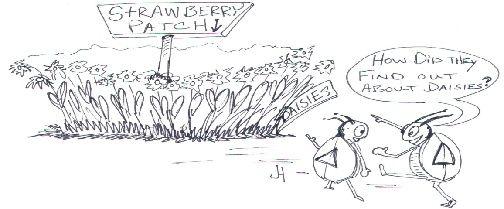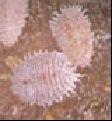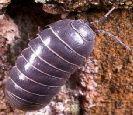Natural Solutions to Things That Bug You (73 page)
Read Natural Solutions to Things That Bug You Online
Authors: Myles Bader

LEAFMINERS
Identification:
 These maggots are green or black and about 1/8
These maggots are green or black and about 1/8
of an inch long. They actually tunnel between the upper and lower leaf surfaces and leave a white trail behind for you to follow.
The adults are flies that are half the size of a housefly, black with yellow markings and hairy.
General Information:
Three or four generations of the fly can hatch every year. They prefer to feed on spinach, berries, potatoes, peppers and cabbage. They will also feed on columbine, roses, nasturtiums and chrysanthemums.
DINNERTIME
Ladybugs and lacewings are an excellent deterrent to these maggots. If you can’t get them try purchasing other parasites such as
Diglyphus begini
or
Diglyphus isaea
.
PEPPER THEM GOOD
Pepper spray is highly recommended as a spray treatment that usually works every time. When the plants are wet try dusting them with lime and this will repel the flies and stop them from laying their eggs.
CROP ROTATION WORKS
It is best to rotate your crops so that the leafminers in the soil gets confused and are unable to find the plants every year in the same spot. If you till in the fall it will also destroy the pupae.
THESE LEAVE YOUR PLANTS TIPSY
The arborvitae leafminer causes browning at the tips of the leaves. Spray plants and trees in late June or early July if you have the problem with a soap spray. Shaded plants are usually more heavily infested.
EGG CRUSHER
Leafminer eggs can easily be seen on spinach plants and can be crushed. If the leaves are heavily infested, it is best to pick them off and dispose of them.

LYGUS BUG
General Information
:
 These bugs are not too fussy what they eat but do prefer beans, strawberries and most orchard crops. The adults may be green, yellow or brown with a yellow or green triangle on their backs.
These bugs are not too fussy what they eat but do prefer beans, strawberries and most orchard crops. The adults may be green, yellow or brown with a yellow or green triangle on their backs.
When they are on beans they attack the buds and flowers causing them to fall off. If they attack tomatoes and fruit they will cause discoloration, bumps or depressions. If you disc or rototill the area and especially the weeds, it will reduce the infestation.
DAISY’S TO THE RESCUE
If you border your strawberry patch with Shasta daisies it will keep the lygus out of the strawberry patch. They will eat the daisies as long as they are flowering and leave the strawberries alone.

MEALYBUG
Identification:
 They are elliptically shaped and have short spines. They have piercing/sucking moth parts and are cottony-looking. The females do not have wings. They prefer soft-stemmed plants and suck out their juices eliminating the plant’s nutrients. Mealybugs love orchids and other exotic plants. They will thrive indoors and like a warm, dry environment. They are capable of producing several generations in a year.
They are elliptically shaped and have short spines. They have piercing/sucking moth parts and are cottony-looking. The females do not have wings. They prefer soft-stemmed plants and suck out their juices eliminating the plant’s nutrients. Mealybugs love orchids and other exotic plants. They will thrive indoors and like a warm, dry environment. They are capable of producing several generations in a year.
To identify a mealybug look on the underneath side of a leaf and around the leaf joints. They look like miniature balls of cotton. The plant will also look withered and have a sticky sap on the leaves and stems.
If you find a problem, move the infested plant and isolate it from any other plants. They are very invasive and will eventually move to all the plants.
One of the easiest methods of control; is to just spray a forceful stream of water at the bugs and just wash them off the plant.
If the water spray is not working then try a spray made from a soap/oil mixture. Prepare a solution of ½ teaspoon peppermint soap, ¼ teaspoon of a horticultural oil (garden supply) and 1 quart of tap water.
General Information:
They are a problem for citrus crops and a number of solutions will kill them and their relatives. They excrete honeydew, which makes them a friend of the ants.
They can usually be picked off the plants with a long tweezers and look like small tufts of cotton on the underneath sides of leaves. In the northeastern United States mealybugs are indoor pests as well.
THE DOUBLE WHAMMY
You can make a spray that is two killers in one by mixing 1 gallon of cool water with 2 tablespoons of canola oil and 2 tablespoons of dishwasher liquid soap. Place the mixture in a power sprayer and spray your plants in the area where the problem exists. The dishwasher liquid soap will kill most of them on contact and the oil will penetrate their skins and eventually suffocate them.
THE MEALY MASSAGE
If you only have a small number of mealy bugs, just keep a spray bottle around with rubbing alcohol in it and give them a squirt. You can also dip a paintbrush in the alcohol or use nail polish remover and paint them; however, be very careful not to touch the plant or the alcohol will cause damage.
PARASITES TO THE RESCUE
There are two parasites that are very effective in controlling mealybugs. They are
Cryptolaemus
ladybug
(not the one we are used to) and
Pauridia
. Both of these should be available through a garden supply or agricultural house.
MEALYBUG KILLER SPRAY
The following ingredients will be needed:
3 Tablespoons of light corn oil
2 Tablespoons of liquid dish soap
2 Gallons of cold tap water
Place all the ingredients in a medium bucket and mix well. Place a small amount in a sprayer and spray the plants that have the mealybugs on them. Give the bugs a good squirt or two.
POKE THEM WITH A TOOTHPICK
Use a toothpick or the point of a knife to pick off mealybugs and scale from a plant. These tools should easily dislodge them without damaging the plant.
PINEAPPLE MEALYBUG
General Information:
 The bug is a whitish/gray insect that is covered with a white, waxy excretion. This bug is the number one pest of pineapple plants. However, the insect has also been known to infest nutgrass, panic grass, Spanish needle, caladium, avocado, citrus, mulberry, royal palm, hibiscus, sugarcane and some ferns. They are known to be the cause of pineapple wilt disease, which results in stunted plants that have leaves of reddish yellow with light green spots.
The bug is a whitish/gray insect that is covered with a white, waxy excretion. This bug is the number one pest of pineapple plants. However, the insect has also been known to infest nutgrass, panic grass, Spanish needle, caladium, avocado, citrus, mulberry, royal palm, hibiscus, sugarcane and some ferns. They are known to be the cause of pineapple wilt disease, which results in stunted plants that have leaves of reddish yellow with light green spots.
The leaf tips of the plants will look dead or are in the process of dying. Fire ants are a real friend of these bugs and will even carry them from wilted plants to healthy plants to get the honeydew they excrete.
PARASITES DO THE JOB
A tiny wasp called
Habletonia pseudoccina
will sting the mealybug and lay her eggs in them. Using a dormant oil spray or sprinkling crushed bone meal around will also help do the job.
PILLBUG (SOWBUG)
General Information:
 These bugs are actually related to lobsters and crayfish and have seven pairs of legs and segmented bodies. They are sometimes called “rolly-polies” since they will roll up in a ball when disturbed. They
These bugs are actually related to lobsters and crayfish and have seven pairs of legs and segmented bodies. They are sometimes called “rolly-polies” since they will roll up in a ball when disturbed. They like moisture and will normally be found in moist areas. If the area becomes dry they will move on. They like to eat ground cover, especially if the ground cover has a good amount of moisture in it. Their favorite home is a corncob and they are also fond of potatoes.
like moisture and will normally be found in moist areas. If the area becomes dry they will move on. They like to eat ground cover, especially if the ground cover has a good amount of moisture in it. Their favorite home is a corncob and they are also fond of potatoes.
